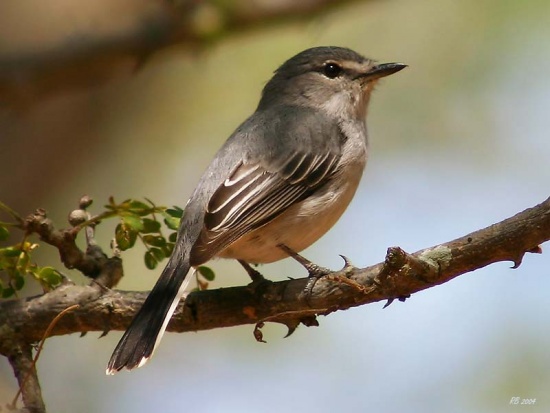(→External Links: Added English name to GSearch.) |
(→External Links: Added variant English name.) |
||
| Line 35: | Line 35: | ||
{{ref}} | {{ref}} | ||
==External Links== | ==External Links== | ||
| − | {{GSearch|"Myioparus plumbeus" {{!}} "Fraseria plumbeus" {{!}} "Grey Tit-Flycatcher" }} | + | {{GSearch|"Myioparus plumbeus" {{!}} "Fraseria plumbeus" {{!}} "Grey Tit-Flycatcher" {{!}} "Lead-coloured flycatcher" }} |
{{GS-checked}}1 | {{GS-checked}}1 | ||
[[Category:Birds]] [[Category:Fraseria]] | [[Category:Birds]] [[Category:Fraseria]] | ||
Latest revision as of 19:56, 1 November 2023
Alternative name Lead-coloured flycatcher
- Fraseria plumbeus
Identification
14 cm
- Slate-grey head, sides of neck, upperparts and scapulars
- Blackish lores
- White supraloral line and eyering
- Outer tail feather is entirely white
Distribution
Widespread throughout much of sub-saharan Africa:
Western Africa: Senegal, The Gambia, Guinea-Bissau, Guinea, Mali, Sierra Leone, Liberia, Ivory Coast, Burkina Faso, Ghana, Togo, Benin, Nigeria, Niger, Chad, Cameroon, Central African Republic, Equatorial Guinea, Gabon, Democratic Republic of Congo, Angola
Eastern Africa: Sudan, Ethiopia, Kenya, Uganda, Rwanda, Burundi, Tanzania, Zambia, Mozambique, Malawi
Southern Africa: Namibia, Botswana, Zimbabwe, South Africa, KwaZulu-Natal, eSwatini
Taxonomy
Formerly placed in genus Myioparus.
Subspecies
There are 3 subspecies[1]:
- F. p. plumbeus:
- Senegambia to north-western Angola, southern Ethiopia, Uganda and north-western Tanzania
- F. p. orientalis:
- Lowlands of eastern Kenya to eastern Tanzania, Mozambique and Natal
- F. p. catoleucum:
Habitat
Riverine forest, mature woodland and savanna.
Behaviour
Diet
Their diet consists of insects, particularly beetles; caterpillars, moths, grasshoppers and ants etc.
References
- Clements, J. F., T. S. Schulenberg, M. J. Iliff, D. Roberson, T. A. Fredericks, B. L. Sullivan, and C. L. Wood. 2014. The eBird/Clements checklist of birds of the world: Version 6.9., with updates to August 2014. Downloaded from http://www.birds.cornell.edu/clementschecklist/download/
- Avibase
- Handbook of the Birds of the World Alive (retrieved April 2015)
Recommended Citation
- BirdForum Opus contributors. (2025) Grey Tit-Flycatcher. In: BirdForum, the forum for wild birds and birding. Retrieved 10 May 2025 from https://www.birdforum.net/opus/Grey_Tit-Flycatcher
External Links
GSearch checked for 2020 platform.1




